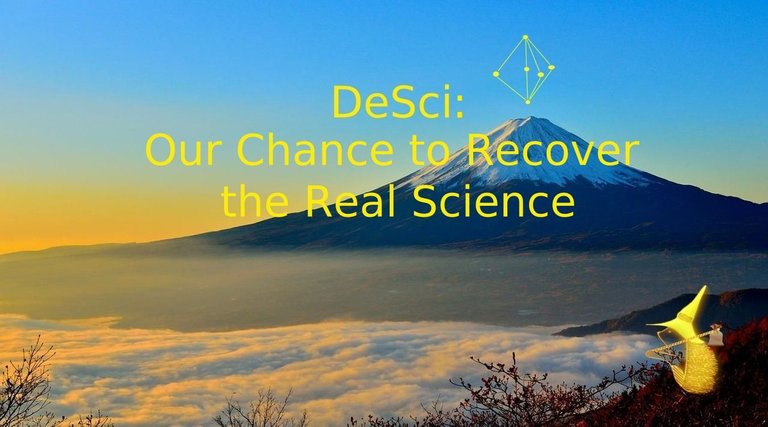
(The image above was composed by me with the help of the hedgehog and fog images. Pixabay)
Our modern science is damaged by the «sickness» caused by centralization and our monetary system. For us to have real science, we need to redesign the context it lives in. We need to redesign the system. Decentralization might «heal» our science from within. It could allow our science to be defined by the people and serve their interests.

All things around us are data-generating machines. It is these data that our science deals with.
We can record data, manipulate it, store it, and exchange it. While we could perform all of these actions without computers, they definitely help us a lot.
And the Internet is the infrastructure that helps us to organize the process and create the appropriate context for the data. The fate of the data and our science depends on the context they are in.
In the centralized internet context, it is just one central entity that decides the fate of the data. It can delete the data it is not interested in or it can come up with the data needed to multiply its profits. In other words, the fate of the data is dictated by the answer to the following question:
How much money will we get?
instead of
What data do people need in order to thrive in this world?
The direction our science mostly evolves in these days is established by the interests of central entities, not the people.
We could either have the biased corrupted science dictated by the corporations (centralized context), or we could have the unbiased science which might help us to reach the highest potential of our minds and souls (decentralized context). Decentralization is what could help us to recover the real science, the one that helps us to be closer to reality, not the one abused to maximize somebody's profits. And the closer our science helps us to get to the reality, the more rational our world-view, the better decisions we make. . .

Once upon a time, there was a group of curious hedgehogs who were trying to understand what reality is. Their curiosity became the basis for what they called science. It was a collection of techniques (observing, recording, running experiments) designed to find out whatever possible about the world and its behavior.
After a while, they realized that science highly depended on the fog that surrounded almost everything. There were two types of fog: the grey one near the ground and the lighter one above it. However, after a while, a lot of the hedgehogs got used to the fog so much that it became a part of their belief system.
One of the hedgehogs was not sure that this environment represented the best one for their science to help them with understanding reality. He was highly interested in getting free energy, but there were some problems he needed to solve in order to implement his ideas.
The only place that was never filled with fog was the top of the mountain dozens of miles away from his village. The Hedgehog realized it was the place he needed to visit in order to find out what could be the best context for science to exist in and for his ideas to turn into reality.
So he decided to go on a journey. During his journey, the Hedgehog met a number of animals.

“They do not want to know that centralization is not only the death-knell of liberty, but also of health and beauty, of art and science, all these being impossible in a clock-like, mechanical atmosphere.”
Emma Goldman
Access to knowledge
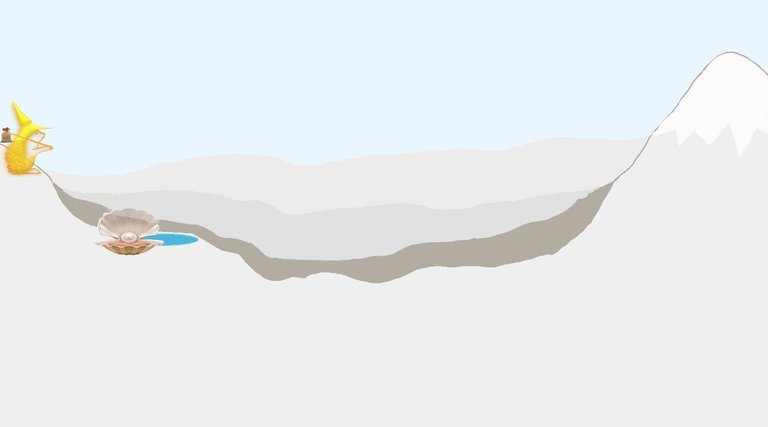
(The image above was composed by me with the help of the hedgehog and perl images. Pixabay)
The first animal he met was an oyster near a pond in the valley. He greeted the Oyster and talked for a while. The Hedgehog mentioned that in order to turn his ideas into reality, he needed more data, but couldn't find them.
“You see, the data you need is hidden from you,” the Oyster explained. “It is hidden behind the paywalls set by the journals issued in your village. It's hard to afford all the data you may need because your village exists in a monetary-based society. The owners of the data are forced to set these paywalls so that they could survive in this society.
“What's more, some of the data get rejected by the journals themselves, because their owners are forced to do so by big corporations. They act exclusively in the interests of their profits, so the ideas that possess a threat to them will be rejected and hidden from the public.
“The first fog near the ground of your village is a result of centralization.”
“Yeah,” replied the Hedgehog, “that sounds reasonable. Plus, let's be honest, nobody knows all the languages and dialects used in different places, so the data one needs may be hidden because of the language barrier. So what could be done about all this?”
“Well, there're solutions,” said the Oyster. “You see, in a high-tech society communication happens mostly with the help of the Internet. And its infrastructure nowadays is mostly centralized and owned by corporations. So it's them who will ultimately decide the fate of the data, not the common hedgehogs.
“The opposite of centralization is decentralization. This approach helps to distribute the power and influence among a number of computers and hedgehogs. It is implemented with the help of a blockchain, a pear-to-pear technology. Blockchain ensures immutability and transparency of the data, which means the data can't be changed without a consensus and are available to everybody. As a bonus, you may have cryptocurrency that may help scientists to monetize their efforts, so that there is no need to set those paywalls.
“By the way, some of the hedgehogs have already united to develop the projects that may help you. For example, STEMSocial is a platform for direct communication between researchers and readers (without any third parties). Powered by the Hive blockchain, it promotes freedom of speech and provides scientists an opportunity to be rewarded with cryptocurrency for their efforts.
Hence, there's no need for scientists to set the paywalls for the content. It also ensures immutability of the information shared on the blockchain. That's why no centralized authorities can delete or change the data, except for the authors themselves. They are the owners of the content. STEMSocial also has a great community of researchers from all over the world.
“As for the language barrier,” the Oyster continued, “some of the hedgehogs are trying to use computational power to automate translation process. It is a high-tech solution. The low-tech is. . . well, try to learn as many languages and dialects as possible. This will help to increase your creativity as well.”
The Hedgehog said goodbye and went forward.

I believe the role of the government is too big. Society must be more decentralized.”
Pavel Durov
Publishing
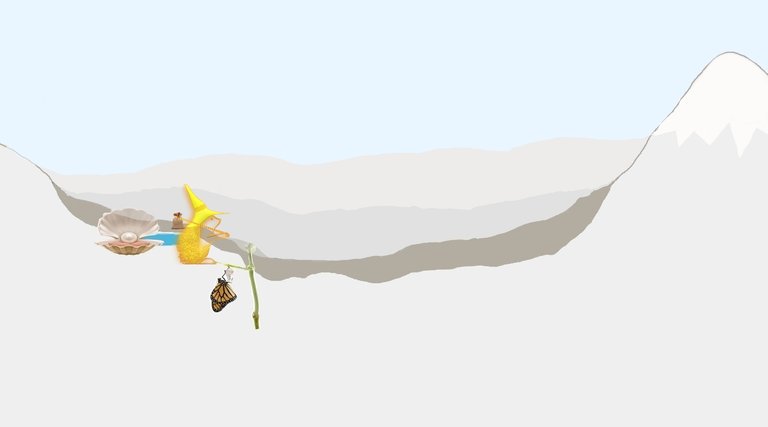
(The image above was composed by me with the help of the hedgehog, perl, and butterfly images. Pixabay)
The second animal the Hedgehog met on his journey was the Butterfly that had just come out of the cocoon. He greeted it and had a little chat. The Hedgehog explained that he needed to share some important results with the world, but neither he could afford to publish a paper, nor any journals wanted to publish his findings regarding free energy. And he couldn't understand why.
“You see,” the Butterfly said, “you have good intentions and want to help other hedgehogs. But that is not what the business of the big corporations is about. All they care about is maximizing their profits. And it's they who own the journals and decide what is allowed to be published. Your innovative ideas could revolutionize the energy industry, but they possess thread to their profits. This happens because centralization dominates in your society.”
“Okay,” said the Hedgehog. “But could the decentralization that I talked about with the Oyster be a solution in this case as well?”
“Yeah, decentralization is the only way,” agreed the Butterfly. “It may allow a lot of hedgehogs to be involved in the peer-review process making it much more transparent. Plus, a decentralized peer review process will ensure the data is trustworthy since they are evaluated by the community of hedgehogs, not just a couple of peers. What's more, more hedgehogs involved means the peer review will happen faster. And, as the Oyster probably told you, blockchain technology and cryptocurrency may help researchers and reviewers to monetize their efforts.
“By the way, some of your hedgehogs have already come up with projects that may help you with publishing your results. For example, there is a project called Seeds of Science. It is a unique way of publishing that promotes creativity and welcomes contributions from the hedgehogs regardless of their academic achievements. The key requirement is that the manuscript (the "Seed") has to provide new ideas that could help to advance science. Seeds of Science is a journal and also a community that uses the hive mind to conduct the peer review process by voting and commenting on the manuscripts.
“Another project that might be of interest to you is Ants-Review. It is a blockchain-powered platform for the open peer review process incentivized by cryptocurrency. The scientific community, including the author of the paper, may contribute cryptocurrency to a pool which serves as a reward for reviewers. This reward is distributed based on the quality of the reviews assessed by the community.
“Plus, you can take a look at SCINET and OpenAccessDAO.”
The Hedgehog thanked the Butterfly and moved to the meadow near the forest.

“Give me control of a nation’s money and I care not who makes its laws.”
Nathan Mayer Rothschild
Crowdfunding
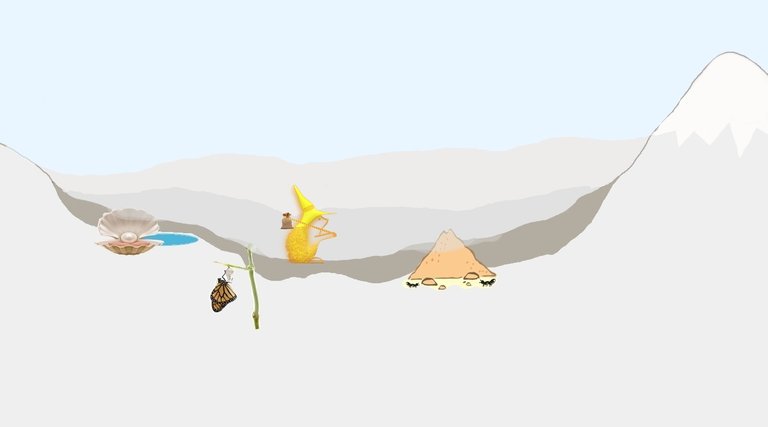
(The image above was composed by me with the help of the hedgehog, perl, butterfly and ants images. Pixabay)
On the meadow, the Hedgehog found mounds with ants. He greeted them and talked a little. He mentioned that he needed financial resources to fund his research.
One of the ants replied, “You are thinking about it the wrong way. It is not the financial resources you need. You don't need a piece of paper. What you really need is resources like equipment, reagents, and materials. Blockchain and cryptocurrency could help you to fund your research in a more decentralized way compared with the traditional academic approach. But, again, it is not the digits on your screen that you need to run experiments. It is the physical resources.
“It may be hard for you to grasp this as long as you think in the context of the monetary system. Money is just an intermediate, a tool that may help to allocate resources. A resource-based economy could help researchers to deal directly with resources. That is all they need.”
“How would the hedgehogs get motivated in such a society?” asked the Hedgehog.
“Well, how does everybody get motivated?”, the Ant replied. “Do you need to be paid to get up in the morning and ensure your own health?
“Imagine a system that provides the hedgehogs everything they need. Would you really need to be paid to support such a system? Wouldn't you want to develop and share your skills with others?
“We already have GitHub. This platform inspired and motivated a lot of the hedgehogs to contribute their time to create and improve software for everybody for free. Yes, it exists in the digital world. But it could be possible to create something similar in the real world as well.
This is what the Venus project is about. According to Jacque Fresco, our behavior is defined by the environment we are exposed to. So by changing the environment, we can get the behavior we need. There could be a global open-source environment for everybody to make contributions based on their skills to the development of any inventions”
“And, remember,” the Ant continued, “that the monetary-based society limits your creativity. So some of the ideas will never be generated in your head unless you get out of this context. The second fog our places are filled with is generated by our monetary system which usually tends to be highly centralized. Money is the wrong motivation. It will never allow you to have the real science done by the hedgehogs, and for the hedgehogs.
“As for running crowdfunding campaigns, there are some projects you can already take a look at, for example, Experiment. It is a platform and a community that allows scientists to run crowdfunding campaigns for their projects and share their findings with the world. The latter serves as a reward for the backers of the projects. Crowdfunding is decentralized, but the decision-making process is still quite centralized because it is the Experiment team who evaluates the projects and decides whether or not a specific project should be funded.
“The latter problem is what another project called ScientificCoin tries to solve. ScientificCoin provides a decentralized crowdfunding platform and a freelancer platform that helps to connect scientists with potential employers.
“What's unique about ScientificCoin is that it tries to organize the project evaluation process in a decentralized manner with the help of the blockchain technology. It's not just one authority who assesses the potential of a specific project for investors, it is the whole community of different specialists who does, using a wide range of criteria. And there are smart contracts created specifically for each project that allow running crowdfunding campaigns.
“Other projects that may help scientists with funding are SCINET and DeSci Foundation.
“Crowdfunding campaigns also can be run with the help of NFTs (non-fungible tokens),” the Ant added. “Any scientific idea or innovation can be represented as an NFT stored on a blockchain.
And there’re some NFT marketplaces, like the one created by RMDSs, that aim to connect scientists with investors and simplify crowdfunding.
“In a monetary society, NFTs also could help scientists to protect and exchange IP (intellectual property). But in a resource-based economy, you most likely wouldn’t even need this.
“DAOs may allow bringing even more decentralization to crowdfunding. But you will learn more about them from the bees near the trees several miles away”
The Hedgehog said goodbye and went into the forest.


(The image above was composed by me with the help of the hedgehog and mountain images. Pixabay)
“Gradually, decentralized trust will be accepted as a new and effective trust model. We have seen this evolution of understanding before - on the Internet.”
Andreas Antonopoulos
Collaboration
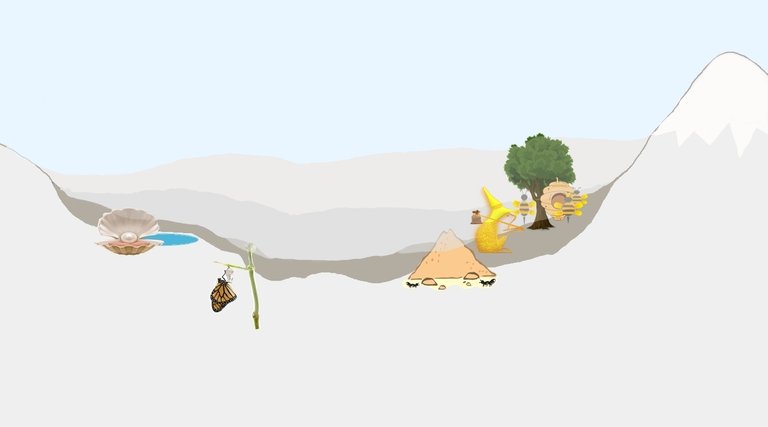
(The image above was composed by me with the help of the hedgehog, perl, butterfly, ants, beehive, and bee images. Pixabay)
In the forest, the Hedgehog found the bees near the trees. He greeted them and had a little talk. The Hedgehog explained that he needed teammates to conduct his research.
“Yeah,” said one of the bees, “having community and collaboration is important because all the hedgehogs around the world are not perfect, they all have their limits and weaknesses. Some have expertise in one area, while others are skilled in another one.
“To get as close to our reality as possible, we need a hive mind, we need a way to exchange ideas and collaborate with each other. That is where collaboration platforms and tools like GitHub, Authorea, Discord and Telegram come into play. But they are quite centralized.
“In order to have a truly decentralized decision-making process on a global scale and an opportunity to allocate resources in a democratic way, it is a good idea to create a DAO (decentralized autonomous organization). For example, VitaDAO is helping to fund longevity research, while Research DAO deals with the research in the field of Blockchain Science.”
“Yeah, it seems like a good idea,” said the Hedgehog, “probably I could create my own DAO dedicated to free energy research.”
“And remember,” the Bee added, “while the Internet could definitely accelerate the development of the infrastructure for decentralized science, it is always a good idea to have a backup plan for a low-tech or no-tech environment. But that is a topic for another journey you will have to make one day”.

The Hedgehog thanked the bees and went forward to the mountain. He climbed the mountain and turned around. There was no fog anymore.
Then he imagined what the future decentralized resource-based society and science could look like. He was trying to define what DeSci is. Finally he realized.
DeSci is an approach to organize scientific ecosystem in a decentralized way to have the real science done by the hedgehogs, for the hedgehogs.

He sat down and opened his bag.
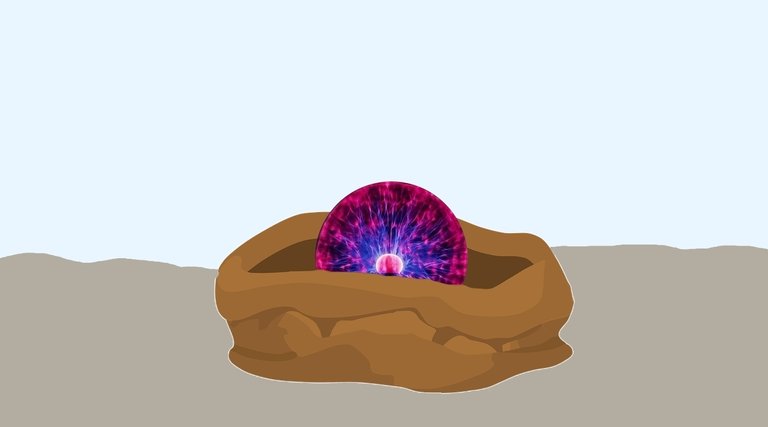
(The image above was composed by me with the help of the bag and Tesla lightning ball images. Pixabay)
This post was inspired by the "Hedgehog in the Fog", a Soviet animated film created in 1975. You can also watch the video version of this post here:
Music:
"Recovery - Breakbeat - Royalty Free Music"
The work is licensed under a Creative Commons Attribution 4.0 International License
The music was modified by me a little.
The video was created by me with the help of Kdenlive and Krita.
The divider was created by me.

Important:
I'm not a native English speaker.
While the post was initially written by me, it was greatly improved by the HackerNoon editors.
I appreciate their work a lot.
The post was originally published on HackerNoon this week.
DeSci: Decentralized Science as Our Chance to Recover the Real Science #decentralized-internet
https://hackernoon.com/desci-decentralized-science-as-our-chance-to-recover-the-real-science

PS:
We use metaphors all the time, and we don't even notice that.
Our thinking is mostly metaphorical.
To help people with understanding and remembering what I wanted to say in the article, I took into account the fact that
stories are much more memorable than facts alone. In fact, some scientists like Jennifer Aaker state that
"Stories are 22 times more memorable than facts alone".
That's why I come up with a metaphorical explanation of ideas I'd like to share.
The metaphors used are inspired by the "Hedgehog in the Fog".
I wanted to show that the modern scientists are sort of "hedgehogs in the fog", and, I hope, you saw why.

Reference
Ants-Review platform
Trovò, B., Massari, N. (2021). Ants-Review: A Privacy-Oriented Protocol for Incentivized Open Peer Reviews on Ethereum. In: , et al. Euro-Par 2020: Parallel Processing Workshops. Euro-Par 2020. Lecture Notes in Computer Science(), vol 12480. Springer, Cham. https://doi.org/10.1007/978-3-030-71593-9_2
Ants-Review MVP Demo x Cool Tools for Science
Charlie Veitch interviews Jacque Fresco in London
"InterReflections", by Peter Joseph
The secret of motivation. Part 1. “$” vs. “for fun”. #1 “Candle problem"
World’s first NFT marketplace for science and tech IP to launch in March
Research Methods and Data Science. NFT Marketplace
IN ENGLISH «Hedgehog in the Fog»
Posted with STEMGeeks
Congratulations @alexbiojs! You have completed the following achievement on the Hive blockchain and have been rewarded with new badge(s):
Your next target is to reach 300 posts.
You can view your badges on your board and compare yourself to others in the Ranking
If you no longer want to receive notifications, reply to this comment with the word
STOPTo support your work, I also upvoted your post!
Support the HiveBuzz project. Vote for our proposal!